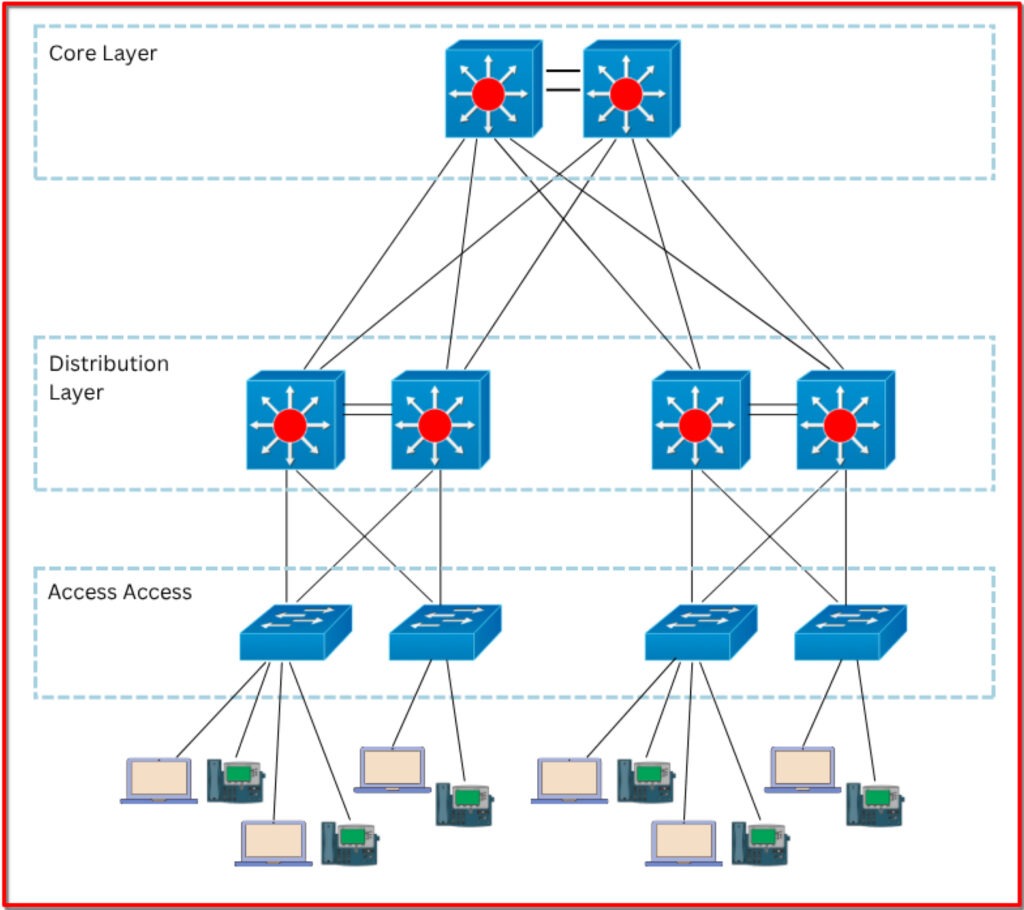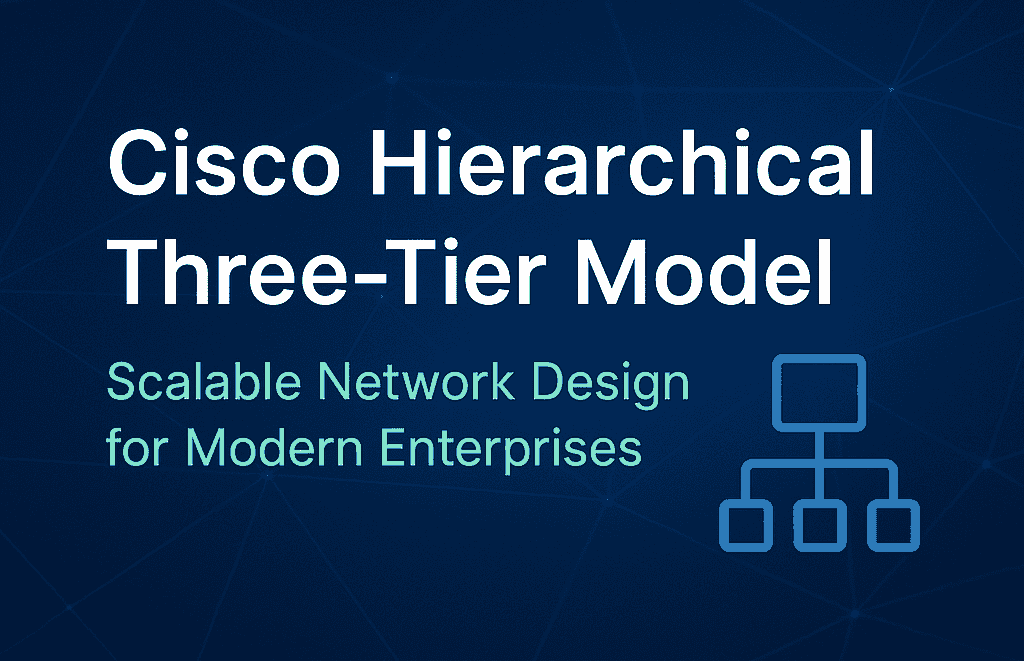🚀 Introduction
In modern enterprise environments, designing a robust, scalable, and manageable network infrastructure is essential. Cisco’s Hierarchical Network Design Model provides a proven framework to achieve these goals. By organizing a network into distinct layers—Core, Distribution, and Access—this model improves performance, fault isolation, and simplifies troubleshooting.
Whether you’re preparing for your CCNA certification or working on a real-world network, understanding this architecture is a must. Let’s break it down layer by layer.
🏗️ What is the Cisco Hierarchical Network Model?
The Cisco Hierarchical Network Model is a design framework that divides enterprise networks into logical layers. Each layer has a specific role and responsibility, helping organizations achieve scalability, flexibility, and high availability.

The three primary layers are:
- Core Layer – The high-speed backbone.
- Distribution Layer – Policy control and routing between subnets.
- Access Layer – Where end devices connect.
This separation allows for better control over traffic, simplifies troubleshooting, and makes it easier to scale and manage complex networks.
🧠 Core Layer: The Network Backbone
The Core Layer is the foundation of the hierarchical design. It handles high-speed data transfer between different parts of the network.
🔹 Key Responsibilities:
- Fast packet switching and routing
- Minimal latency and high reliability
- Redundant paths for fault tolerance
🔹 Design Principles:
- Avoid adding complex services (no firewalling or ACLs)
- Optimize for speed and resilience
- Use of high-speed links and hardware
🔹 Technologies Commonly Used:
- Layer 3 switches
- Routing protocols (OSPF, EIGRP)
- Redundancy protocols (HSRP, VRRP)
Think of the Core as the express highway of your network—it shouldn’t get bogged down with traffic lights or checkpoints.
🏛️ Distribution Layer: The Policy Enforcer
The Distribution Layer connects the Access Layer to the Core and acts as a traffic control point. It’s where decisions are made regarding traffic flow, security, and routing between VLANs.
🔹 Key Responsibilities:
- Inter-VLAN routing
- Implementing ACLs and security policies
- Load balancing and traffic shaping
- Aggregating Access Layer connections
🔹 Technologies and Features:
- Layer 3 switching
- Access Control Lists (ACLs)
- Route summarization
- QoS (Quality of Service)
This is the brain of your network—it ensures policies are enforced before traffic hits the core.
🧩 Access Layer: Where Devices Meet the Network
The Access Layer is where end-user devices (laptops, IP phones, printers, wireless APs) physically connect to the network.
🔹 Key Responsibilities:
- Connecting clients to the network
- Segmenting traffic using VLANs
- Enforcing port-level security and policies
🔹 Technologies and Features:
- Layer 2 switching
- VLANs and trunking
- Port security
- 802.1X authentication
- Spanning Tree Protocol (STP)
This is the front door of your network. Security and control at this layer are critical to prevent attacks or misconfigurations from spreading.
🔁 Redundancy and Scalability
One of the biggest advantages of the hierarchical model is scalability. By logically separating roles and functions, it becomes easier to:
- Add new users and devices without redesigning the entire network
- Introduce new distribution or access switches modularly
- Implement redundancy at each layer to minimize downtime
🔄 Redundancy Best Practices:
- Use EtherChannel or LACP for link aggregation
- Deploy first-hop redundancy protocols (HSRP, VRRP, or GLBP)
- Maintain dual links between layers when possible
This modular approach ensures that maintenance or failures in one part of the network don’t bring down the entire infrastructure.
🧪 Real-World Usage & Model Variants
🔍 Typical Use Cases:
- Enterprise networks
- Large campus environments
- Data centers with modular switch designs
🔀 Collapsed Core:
In smaller networks, the Core and Distribution Layers are often merged into one. This “two-tier” model—also called a collapsed core—is more cost-effective for small to mid-sized businesses without sacrificing too much performance.
🧠 Final Thoughts
The Cisco Hierarchical Three-Tier Model remains one of the most reliable frameworks for building scalable and resilient enterprise networks. By dividing the network into Core, Distribution, and Access layers, you can simplify management, improve performance, and ensure long-term scalability.
Whether you’re designing your first business network or refining a large infrastructure, mastering this model will strengthen your ability to create networks that are both efficient and future-ready.




